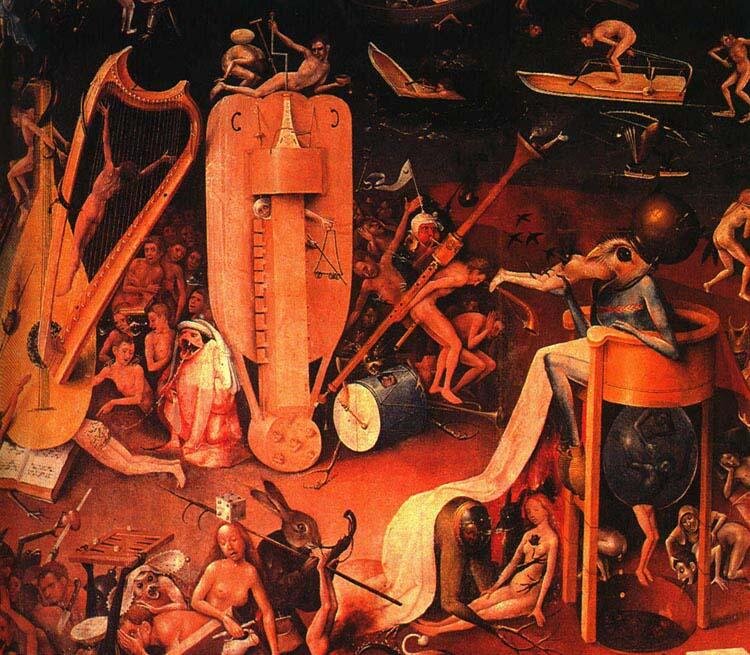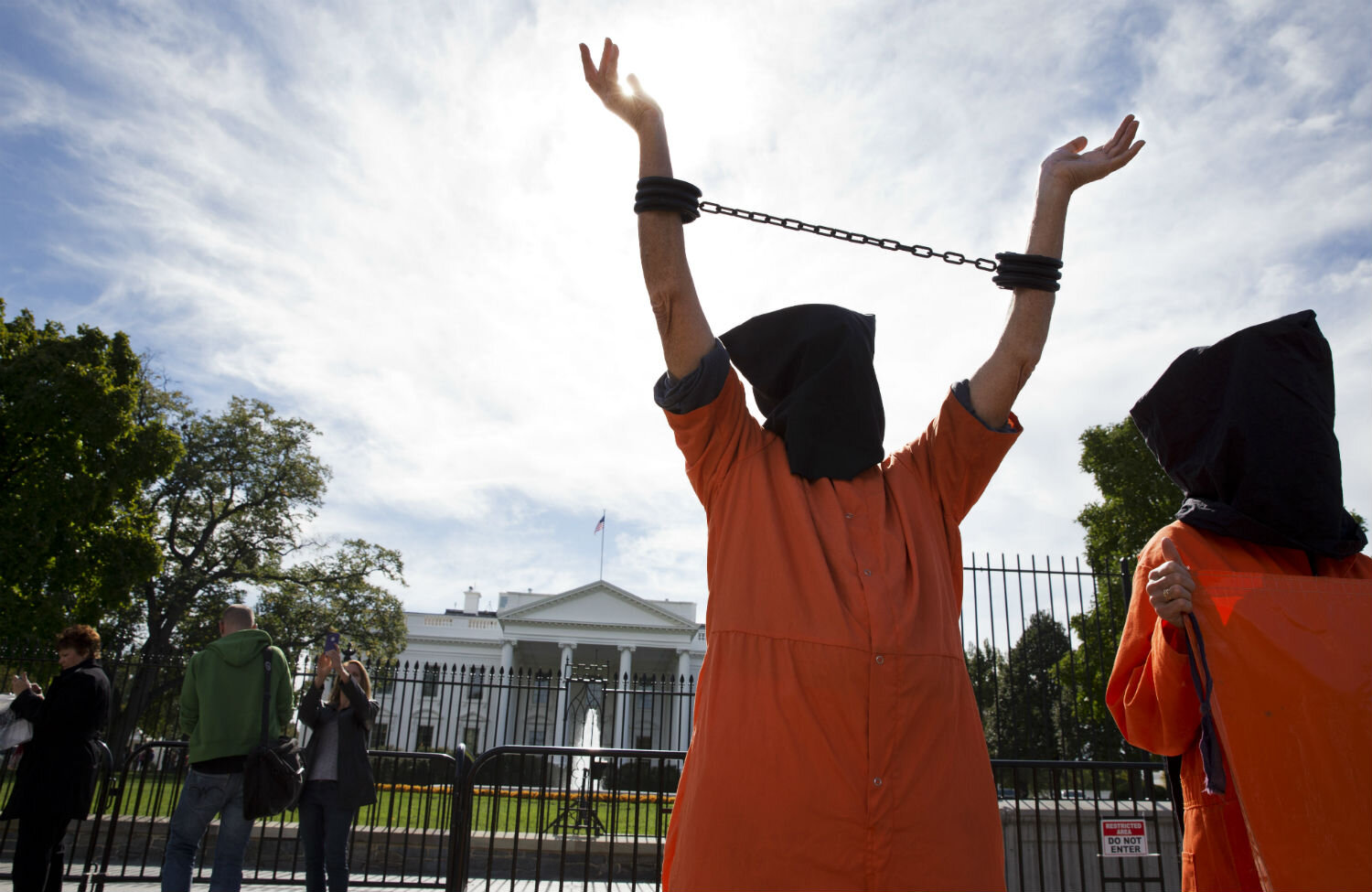
THE TRUTH IS, WE HAVE A RIGHT TO KNOW WHY WE’RE UNDER ARREST AND WHAT WE’RE BEING CHARGED WITH.
The writ of habeas corpus is in the Constitution to shield us against unlawful and indefinite imprisonment. It is also in the Universal Declaration of Human Rights. Habeas is a common law right to protect individuals from their governments, or ours. Thus, when the CIA grabs suspects abroad and renders them to black sites, it violates the Constitution, the UDHR and common law. To make a related point, recently Alon Ben-Meir, an American senior fellow at NYU who has been Israel’s top negotiator with Turkey, published an op-ed criticizing Turkey’s human rights record for the mistreatment of thousands of its political prisoners. “The detention and horrifying torture of thousands of innocent people for months and at times for years, without being charged, is hard to fathom.” We agree, but anyone could just as easily write, “The detention and maltreatment of Palestinian prisoners in Israeli jails for months and years, without being charged, held at length under administrative detention, is hardly the modus operandi of a western democracy.” Except that the United States continues to do the same in Guantánamo. In our centerpiece this month, Lisa Hajjar takes us inside the war on terror and the dystopia that is Guantánamo. —Editor
Lisa Hajjar
Since 2010, I have been to Guantánamo 13 times. I can’t go as a scholar conducting research or a concerned citizen, so I go as a journalist. When I tell people that I am heading off to Guantánamo, responses tend to range from bafflement to curiosity. Highly educated and politically-aware acquaintances have said things like: “oh, I forgot that place was still open” and “what’s going on there these days?” The symbolic nadir of the US “war on terror” has faded in popular consciousness without actually fading away. Guantánamo is still open, and one of the things going on there (although disrupted, like everything else, by the global Covid pandemic) is the military commission case against five men charged with plotting the terrorist attacks of September 11, 2001. Those attacks triggered the “war on terror” which is now approaching its twentieth anniversary. The 9/11 case, which started in 2008 and then restarted in 2011, was supposed to provide justice for the thousands of people killed on that terrible day.
“The 9/11 case, although it garners little media attention or public interest, is an important battleground for truth about torture.”
The 9/11 case mired in the pre-trial phase, meaning that it is nowhere near an actual trial. If you ask why, the answer is torture. Torture is also the reason—or one of the reasons—the general public has forgotten about Guantánamo. The post-9/11 US torture program is like a repressed national memory; it is repressed literally through classification and repressed figuratively because there is no public script for reckoning with the fact that Guantánamo and the military commissions are toxic byproducts of decisions to authorize coercive interrogations, forced disappearance, and protracted incommunicado detention. To give one example of this repression, since 2017 the prosecutors in the 9/11 case have refused to speak to the media. This blackout tactic is a means of avoiding any obligation to give quotable answers to questions about the role of torture in the perpetual delays in the case.
Inside the military commission, however, torture is a constant topic as adversaries argue over the discovery of classified information, judicial rulings, protective orders that govern the defense teams, and conditions of confinement for the five men on trial. At a hearing on March 1, 2018, defense attorney Alka Pradhan summed up the situation: “Torture is…the nasty center of this case whether we like it or not, and we have to deal with it.”
“Torture has to be a central factor of the 9/11 case because the government is seeking the death penalty against defendants who were disappeared into CIA black sites and brutally tortured for years.”
The pretrial process in the 9/11 case has been dominated by battles over discovery of information about the CIA’s Rendition, Detention, and Interrogation (RDI) program. This kind of exposure is not what the agency bargained for when the kidnapping and black site mission was launched in the aftermath of 9/11. The “logic” of the RDI program was not geared to the prospect of future trials but rather was guided by the belief that coercive and violent tactics would be effective in acquiring “actionable intelligence”; as former Vice President Dick Cheney explained: “Intelligence officers of the United States were not…trying to get terrorists to confess to past killings; they were trying to prevent future killings.”
Bush administration officials had assured the CIA at the start of the “war on terror” that suspected terrorists who were captured and transferred to undisclosed locations would never see the light of day, and that the interrogation methods used on these “high value detainees” (HVDs) would remain top secret forever. Those assurances were demolished by the Supreme Court’s 2006 ruling in Hamdan v Rumsfeld. The most critical element of that decision was the conclusion that Common Article 3 of the Geneva Conventions, which prohibits torture and outrages on human dignity, applies to all war-on-terror detainees in US custody overseas. As a result of Hamdan, the Bush administration was compelled to empty the black sites. Fourteen HVDs were relocated to Guantánamo in September 2006, including the five now facing prosecution for 9/11.
One immediate problem the Bush administration faced was how to protect the top-secret information in the HVDs’ possession, namely their own memories of being extraordinarily rendered, forcibly disappeared, and tortured by the CIA. To keep their embodied secrets secret, the HVDs are housed in a clandestine facility on the naval base, guarded by a special unit with top security clearance. Camp 7 is functionally equivalent to a black site because its location, its cost, its features, and the identities of all personnel who work there—including medical professionals—are classified. The only reason we know the facility is called Camp 7 is due to a redaction error.
A bigger problem was how to prosecute people whose experiences of CIA torture are classified? How can keeping secrets and seeking the death penalty commingle in a process that bears any approximation to legal justice? In 2007, the Pentagon built a new high security courtroom designed specifically for the 9/11 case. It has a sound-proof gallery at the back and an audio feed with a forty-second delay and a silencing mechanism to prevent “the public”—a category composed of journalists, NGO observers and family members of victims of 9/11 who travel to Guantánamo—from hearing classified details about CIA’s torture program during open court sessions. Another secret-keeping strategy, assisted by a pliant Congress, was to pass the Military Commission Act of 2006 that would permit prosecutors to use classified evidence that defendants would not be able to see or challenge.
Despite these abundant advantages for the government, the Bush administration did not achieve the desired result of quick guilty verdicts. At the 2008 arraignment, Khalid Sheikh Mohammad, the alleged “mastermind” of 9/11, announced that he rejected his government-appointed military counsel and would represent himself. Then he stated that he would plead guilty immediately on the condition that he go straight to execution. Several of the other defendants followed suit. This contingency of martyrdom by military commission had not been anticipated and the case was derailed before George Bush left office.
The Obama administration inherited Guantánamo, the military commissions, and the responsibility to keep the CIA’s secrets. When President Obama decided to continue using the commissions, Congress passed a revised MCA in 2009 which tightened the rules of evidence to exclude any use of coerced statements and guaranteed that defendants facing the death penalty must be represented by learned counsel (lawyers with capital trial experience). The 9/11 commission case restarted in 2011.

This case presents an impossible tangle of conflicting interests with torture at the nasty center. The five teams of defense lawyers, all of whom have top security clearance, insist that detailed information about what happened to their clients in CIA custody must be discoverable, not least because in capital cases heightened due process applies. The prosecution insists that this trial is about the defendants’ alleged roles in the 9/11 terrorist attacks and what happened to them afterward (i.e., in black sites) does not bear on their involvement in these events. The CIA, as the original classification authority (OCA) of black-site-related information, has the decision-making power to determine what kinds of information are discoverable; the agency’s self-interest is not due process but the protection of its secret “sources and methods.” The prosecution functions as a proxy for the CIA and enforces OCA decisions about what the defense teams need to know. In lieu of providing the defense with original materials about the RDI program, prosecutors produce—and the judge reviews and approves—summaries of select materials that the CIA has deemed relevant and discoverable; those summaries obscure specific dates and locations and mask the identities of people with “unique functional identifiers” and pseudonyms (e.g., Interrogator 1, Dr. Shrek).
Because the defense teams have access to some classified information about the CIA’s torture program, they are regarded with suspicion as weak links in the chain of secrecy. This has led to multiple instances of governmental monitoring and spying on them. In 2014, the case was nearly derailed when the defense teams learned that the FBI had tried to turn some non-lawyer members into informants and had succeeded in recruiting several people on one of the teams. Although the prosecutors had no role in these spy operations, as the government’s representatives they had to argue, repeatedly, that the case is not too damaged to proceed.
The conflicts of interest have escalated precipitously over the last four years. In September 2017, prosecutors issued a new protective order that imposed heightened restrictions on the defense teams’ prerogatives to conduct their own investigations. These restrictions prohibit them from independently contacting any person who may have been associated with the CIA, although after some courtroom wrangling, exceptions were made to the handful of people whose CIA roles are now public information. Prosecutors also wanted to restrict defense team members from traveling to countries that hosted black sites on the grounds that this could be deemed to confirm classified information, despite the fact that the locations of former black sites are publicly available through the reporting by journalists and human rights organization, lawsuits in the European Court of Human Rights, and pre-trial investigations by prosecutors for the International Criminal Court. During the January 2018 hearings, the chief prosecutor, General Mark Martins, defended the restrictions on defense teams as a national security necessity and castigated defense lawyers for trying to become their own “private attorney general, or whatever disembodied investigative authority they think they have outside the commission.”
The tangle of conflicting interests has come to engulf the FBI because of its role in producing ostensibly court-worthy evidence that the prosecution intends or hopes to use at trial. After the HVDs were transferred to Guantánamo in 2006 and plans got underway to prosecute them, the FBI was tapped as the government’s solution to the problem of how to get “clean” statements from people who had spent between three and four years in black sites. In January 2007, FBI “clean teams” were dispatched to Guantánamo to interrogate the HVDs. The official narrative about the FBI clean-team process goes as follows: Whatever happened to these men before they were transferred to Guantánamo is over but nevertheless remains classified. Whatever statements they made during their time in CIA custody will not be used by military commission prosecutors. Whatever statements they made to FBI clean-team agents is court-worthy by virtue of the conduct of interrogations using conventional and lawful means.
This narrative depends on the presumption that the FBI was institutionally separate from the CIA and had not dirtied its hands after 9/11 by using or colluding in torture. A wrecking ball hit this narrative in December 2017 when the defense teams were finally given several documents pertaining to the FBI clean teams. One of the documents, a memo dated January 7, 2007 which set out clean team procedures, revealed that the CIA controlled the process. The FBI agents were instructed to document their interviews with HVDs on a CIA-supplied laptop and to submit their interrogation notes to the CIA for classification review. If anything about torture were to come up in these interviews, agents would have to treat this as “compartmented information” and put it into a separate document.

But the taint of torture goes further than CIA control of the FBI’s interview process, as was revealed by FBI agents on the stand during the December 2017 hearings. Under cross-examination by Walter Ruiz, learned counsel for Mustafa Hawsawi, Agent Abigail Perkins testified that she had reviewed CIA black-site cables to prepare questions and strategies for her interrogation of Ruiz’s client. While this black-site leakage into the process to obtain court-worthy evidence was not surprising to the defense teams, this was the first time it was put on record in open court. When Ruiz asked Perkins whether she had taped the interview—which she conducted without an interpreter despite the fact that Hawsawi is not fluent in English, she said no because the CIA ground rules prohibited it. These bombshell revelations damaged two illusions on which the government’s case depends: one, that evidence produced by the FBI is untainted by the CIA torture program, and two, that “torture time” can be separated from “post-torture time.”
The hearing on March 1, 2018, put the torture-centered tangle of conflicting interests on full display. Defense attorney Pradhan had spent hundreds of hours over the two previous months reviewing and analyzing the materials about the CIA torture program that were made available to the defense through discovery. She took the courtroom podium to argue that because the flaws, errors, and gaps in these materials were so great, the defense teams must be able to access the original documents to do their own assessments. To illustrate the deficiencies, Pradhan contrasted the publicly available three-page chronology of Gul Rahman’s month-long detention at a black site in Afghanistan before he died (of exposure) in 2002 with the classified chronology of her client Ammar al-Baluchi’s three-and-a-half-year detention at multiple black sites, which is one-quarter of a page.
The judge at the time, Col. James Pohl, asked Pradhan if she was asking him to reconsider the summaries he had approved. (Under the MCA, the defense has no right to ask for reconsideration.) She replied, “No, sir. I’m asking you to compel the government to provide us all the original documents.” Pradhan reminded Pohl of the recently exposed collaboration between the FBI and the CIA, which “is relevant and material” to the government’s case. She concluded, “So at a minimum, the government has spent nearly six years since the arraignment, frankly, wasting our time.”
Jeffrey Groharing, one of the prosecutors, took the podium to defend the discovery process and described the request for access to original materials as an “extreme remedy” which he urged the judge to reject. The secrets contained in the original materials, he explained, are “the most highly classified information that the government has.… [I]t’s extremely important that we protect that information.” Then he offered what was intended to be an assuaging statement: “The original classification authority [i.e., the CIA]…yesterday, issued guidance that would allow additional dates to be provided in certain materials, not all dates.”
James Connell, al-Baluchi’s learned counsel, explained to the judge that the defense teams need detailed and original information about the defendants’ black site years not only to prepare mitigation arguments for the sentencing phase if the men are found guilty, but also for the guilt-or-innocence phase of the trial. The defense teams’ objective on this matter is to suppress statements the clients made to FBI agents as fruit of the poisonous tree.
After Connell spoke, Groharing returned to the podium to reiterate the government’s position. He insisted that the defense teams don’t need original materials because they have already been provided with enough information—17,000 pages of summaries—to “paint a very vivid picture… as long as it’s tethered to reality…We’re not going to quibble… about whether Mr. Mohammad was waterboarded 183 times or 283 times. We, frankly, think that has little relevance to the commission and the issues before it.” Groharing also said that the defense teams have an excellent source of the information they seek: their clients.
James Harrington, learned counsel for Ramzi bin al-Shibh, responded: “[S]aying …that we should focus on the guilt or innocence part of the case and not the sentencing part…is total ignorance of what capital law is all about.” Moreover, the prosecution has no right to “tell the court or us” how to defend our case. Harrington described Groharing’s assertion that the defendants—whose torture continues to affect them profoundly—can be reliable sources of classified information as “just preposterous.”
Pradhan weighed in: “[T]here is a straight line between what we’re asking for”— original materials about the black site years—and subsequent statements made to the FBI that the government is trying to use to execute her client and the other four defendants. To illustrate the point, Pradhan read from a declassified account of one short period of al-Baluchi’s experience in the black sites: Prior to his interrogation on May 20, 2003, he “had been kept naked in the standing, sleep-deprivation position since his initial interrogation session” three days earlier. He “was significantly fatigued during this session.… His resistance posture had begun to decline. He appears to be answering questions truthfully. He was presented naked for this session. He was allowed to sit in reward for his increased cooperation.… In any case, he was able to complete the interview successfully despite the sleepiness that he exhibited.” Then she quoted a CIA contractor psychologist involved in black site interrogations: al-Baluchi “is still developing a sense of learned helplessness which is contributing to his compliance, and the team will continue to lessen the intensity of the interrogation sessions relative to [his] cooperation.” Pradhan concluded her comments about the long-term consequences of this treatment by citing the declarations of two neuroscientists that “memory is changed by torture…brain function is changed by torture.”
During the hearings in July 2018, several of the defense teams explained to Judge Pohl that the heightened restrictions had shut down their abilities to conduct their own investigations which, prior to the previous September, had been going well. The prosecutors were adamant that the restrictions were necessary to protect state secrets and that the work-arounds on offer should be adequate. These work-arounds would require the defense to give the prosecution identifying information (e.g., pseudonyms) of CIA-associated personnel they want to interview so that the prosecution could contact those individuals to ask whether they would be willing to speak to defense team investigators. If they say no, that option is closed, and if they say yes, the CIA would then instruct those individuals about what information and topics can and cannot be discussed. The prosecutors were unwilling to budge on defense appeals to restore the status quo ante.
On August 17, 2018, Judge Pohl issued a ruling that was a stunning and rare victory for the defense: he ordered the suppression of all FBI clean team evidence as a sanction for government prohibitions on defense interviews with CIA employees and contractors involved with the torture program. Then Pohl retired. His successor, Col. Keith Parrella—who never read through the reams of court records and case transcripts after he was appointed, set aside Pohl’s ruling to suppress the FBI evidence and in May 2019 he ordered new briefs to (re)consider whether to permit the government to use statements elicited by the FBI clean teams. Then Parrella announced that he was leaving for a different assignment.
The third judge on the case, Colonel Shane Cohen, made headlines in August 2019, a month into his new job, when he set a trial start date of January 11, 2021. By the end of that month, he acknowledged that the case’s complexities and unresolved issues might make that timeframe unrealistic. During the three weeks of hearings in September 2019, there was a unique turn in the case. Unlike previous hearings which have been consumed by motions fights over the discovery of information, protective orders, and conditions of confinement for the five men on trial, this time, there were live witnesses to testify and be cross-examined, including the two FBI agents who had testified in December 2017.
At the start of the hearing on September 16, 2019, Connell asked Judge Cohen if he could make a brief statement before the first FBI witness was called to the stand. Permission granted. “Sir,” he said,
I would be remiss if I did not remark [that today is the eighteenth anniversary] of the…decision of the United States, my government, to use torture as an instrument of policy and investigation. [W]e’ll hear important testimony today about the events of 9/11, a mass murder in which many people were killed. The trajectory of our [nation’s] history was changed and many people, some of whom are in this courthouse, suffered. The key to this hearing and, I would suggest as a policy matter above my pay grade, to the healing of our country is to understand that both of those narratives are true at the same time. Our nation suffered a grievous wound, and it failed to live up to its principles afterward. Both of those things are true at the same time.
Connell was alluding to the fact that on September 16, 2001, President George W. Bush secretly authorized the CIA to hunt and capture “high value” terror suspects. This authorization greased the skids for the Agency to dust off its Cold War playbook and operationalize the mythology that physical and psychological violence are effective means of obtaining accurate information and, therefore, are necessary to wage and win a “war on terror.”
The suppression hearings that began that September represented a major turn from defense teams’ struggles to get information that the government has withheld to a new struggle to exclude statements the government wants to use on the grounds that they are fruit of the poisonous tree. For Connell, one of the objectives was to illuminate that the FBI was far more implicated in the CIA torture program than is publicly known. Connell methodically dismembered the official narrative that the FBI kept its hands clean of torture in the “war on terror.” Under questioning, witnesses revealed that FBI collusion and information-sharing with the CIA dated back to 2002. Because FBI agents were barred from direct access to HVDs in CIA custody in the black sites, they sent questions arising from their own investigations to be asked by CIA interrogators while the torture program was operating at full steam.
During the October 2019 hearings, among the witnesses were several individuals connected to the secretive Camp 7 whose location on the base and the identities of those who work there are classified. One of the facts that came out was that the guard force, Task Force Platinum, is manned by people who dress up like US soldiers but are not actually Department of Defense employees, which suggests that they are CIA agents or contractors.
The last hearings before COVID ground the world to a halt were in January 2020. The witnesses included the two psychologists contracted by the CIA to run operations in the black sites, James Mitchell and Bruce Jessen, who were the “masterminds” of the torture program. They had “reengineered” techniques from the military’s SERE training program (Survival, Evasion, Resistance, Escape) for the purpose of reducing HVDs to a state of “learned helplessness.” Mitchell’s classified identity was first revealed by Jane Mayer in The New Yorker in 2005, and both were featured in a 2007 exposé by Katherine Eban in Vanity Fair. For years after they were outed, the duo kept a resolutely low profile. That changed in April 2014 amidst the fight over the fate of the Senate Select Committee on Intelligence report about the CIA’s RDI program. Mitchell gave his first interview to the Guardian and ever since he has been a vociferous defender of the theories of learned helplessness he put into practice in the black sites, which he claims was done in the service of his country.
On the stand in January 2020, Mitchell testified about his objectives and techniques: If detainees’ psyches were destroyed, they would be incapable of resisting interrogators’ demands for information about terror plots and networks. The human experimentation that Mitchell described (albeit not using that phrase) is now part of the record; he explained that when he interrogated Khalid Sheikh Mohammad, he found that waterboarding wasn’t an effective method but “walling” (smashing a detainee into a wall while wearing a padded chain around his neck) worked quite well. This information reverberated back to a hearing in April 2018, when one of Mohammad’s lawyers, Gary Sowards, explained that an MRI revealed traumatic brain injury consistent with his torture in the black sites. As Sowards drew the connection between Mohammad’s brain damage and experiences of having his head repeatedly bashed into walls and being waterboarded 183 times, there was an audible gasp from people in the gallery. Sowards was making the point, often voiced by defense attorneys, that the government that tortured Mohammad forfeited the right to execute him.
The conflicts of interest in the 9/11 case could go a long way toward being untangled if the government made a choice: Either prioritize the CIA’s secrets and take the death penalty off the table or continue to seek the death penalty and respect the adversarial process by enabling the defense to access more information—including, for example, the full SSCI report. The prosecutors reject the notion that they must make such a politically unpalatable choice and have resolutely refused the plea bargain option. From the government’s point of view, anything short of guilty verdicts and death sentences would seem like a tremendous loss in a case of such monumental importance.
The 9/11 case, although it garners little media attention or public interest, is an important battleground for truth about torture. Indeed, this is the last active front in this battle. Official secrets, grand lies, and popular myths about torture are being exposed and challenged, motion by motion and witness by witness. At the most basic level, the legacy of torture has undermined the ability of the government to use this case to provide justice for the thousands of victims of 9/11. It has also damaged the pretentions that government secrets and a fair trial with death on the table are compatible. We cannot predict how this case will end, but one thing should be clear: the history of the United States in the twenty-first century is being written in the high security courtroom in Guantánamo.
The incommensurable truth is that the 9/11 defendants are accused of causing the deaths of thousands of people, and they are victims of US torture; both of these are true at the same time. These men, whom the government wants to convict and hopes to execute, literally embody the high costs and long-term consequences of torture.





3 comments